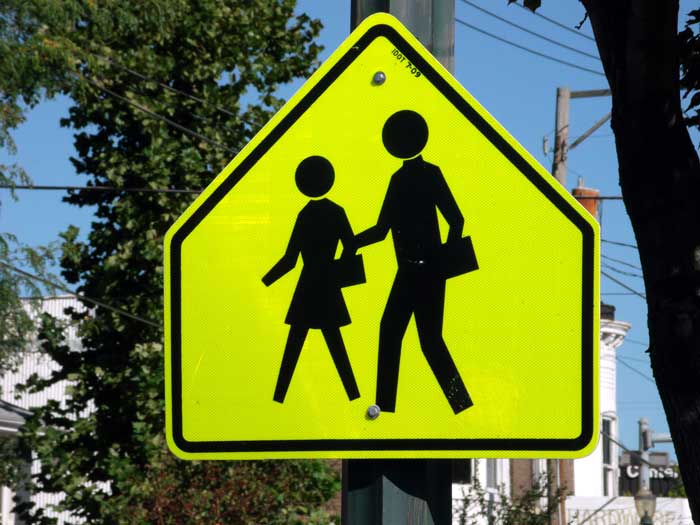Ever hear of the term “jaywalking”? This slang word became popular during and around the 1920s when the automobile industry started booming. There was a rapidly growing consumer market for cars, though an impressive average of 80% of people still chose to use their feet. This lead to difficult driving times for drivers, as their new cars couldn’t be used to full potential with the pedestrians sprawling all over the roads. People with a powerful authority in the automobile industry began campaigns which made people believe that jaywalking was illegal. This was done in hopes of clearing the roads of pedestrian nuisances and giving vehicles more dominance. (History of the U.S. Automobile Industry)Now, almost a century later, we still use the term jaywalking with the idea that it has some sort of legal presence. This, however, is not the case. While there are a few situations where it is illegal to cross the road, the most commonly identified form of jaywalking—crossing where there is no crosswalk (i.e. the middle of the road)—is totally legal in Florida. Crossing outside of a crosswalk, however, requires you to yield to traffic, instead of traffic yielding to you.
If you’re ever—as a pedestrian—hit, injured, or in a dispute, and are being held accountable for the accident due to your negligence as a pedestrian; consider the situation. Did you know that legally, a sidewalk is whatever part of a road that is intended for pedestrians (which can be improved for pedestrians by paving)? (More information on Sidewalks, Walkways and Paved Shoulders) Imagine a narrow, curving road with grassy trenches on both sides. You’re walking home from a long day’s work and a car follows the curve along the road, eventually nailing you with the front right side of his car. He jumps out and yells at you, “Dude, why weren’t you on the sidewalk?” In this situation, clearly there isn’t a proper sidewalk; but that doesn’t mean you weren’t on one. If you’re living in an area with sidewalks which you’d consider unfit for pedestrian traffic, contact your local city headquarters and let them know! If you were in an accident because you had no safe place to travel by foot, you may have a case.
If you’re driving down the road and you see a vehicle stopped ahead of you even though he or she’s got a green light, it’s always best to assume that they’re letting a pedestrian pass. If they’re in your lane, be patient and wait to see what’s going on; the worst thing you can do is honk your horn and dodge around them—you could end up hitting someone! If you’re in the lane next to them, this can be an especially hard accident to avoid, especially if the vehicle stopped is large in size, effectively blocking your view. If you hit a pedestrian in this situation, you will almost always be held accountable for the accident; this is because when approaching a crosswalk, you are legally obligated to yield to pedestrians, and therefore should ALWAYS assume there is one crossing at any given time. If, however, the pedestrian did NOT have a walk signal, and you’re still being held liable for the accident, you may have grounds for a winning case. There are proper steps you, as a pedestrian, can take if you are ever struck by an automobile.
Unmarked crosswalks still count as crosswalks. Unmarked, unpaved or not-at-all-existent sidewalks still count as sidewalks if that portion of the road was not intended for vehicle use. Legally, crosswalks are the continuation of the sidewalk across the roadway. This means that even with an unpaved sidewalk connected to an unmarked/unpainted crosswalk, you, as a pedestrian, are still entitled to your pedestrian rights pertaining to those areas. This also means that for drivers, just because it appeared that they weren’t walking on a crosswalk because there were no painted lines, they probably still were, but the case and situation would have to be evaluated to properly identify the individual who was at fault.
It’s not unheard of for pedestrians to be held legally liable in an accident which wasn’t their fault at all. In fact, it’s actually quite common. This happens so often because pedestrians don’t know their rights and fail to learn them during the time of the case. If they were to simply speak with an attorney, they might realize that they’re being taken advantage of and be rewarded accordingly. Here at Dolman Law, we strive to find victims of these cases the compensation they deserve and are owed. If you or someone you know has suffered from losses—be it emotionally, physically, or monetarily—experienced a loss of enjoyment of life, or has died as a result to someone else’s negligence, compensation may be available. Don’t wait another minute to start your case; Dolman Law Group Accident Injury Lawyers, PA offers a free consultation and case evaluation, giving you the risk-free opportunity to learn your rights and options. Call us today at 727-451-6900 or use our quick and easy online form to speak with an experienced personal injury attorney and get started on your case today!
Dolman Law Group Accident Injury Lawyers, PA
800 North Belcher Road
Clearwater, FL 33756
727-451-6900
Contact with our Online Form
Useful Pages:
- Law: Observing Pedestrian Crosswalks
- Florida Pedestrian Safety
Resources Used:






